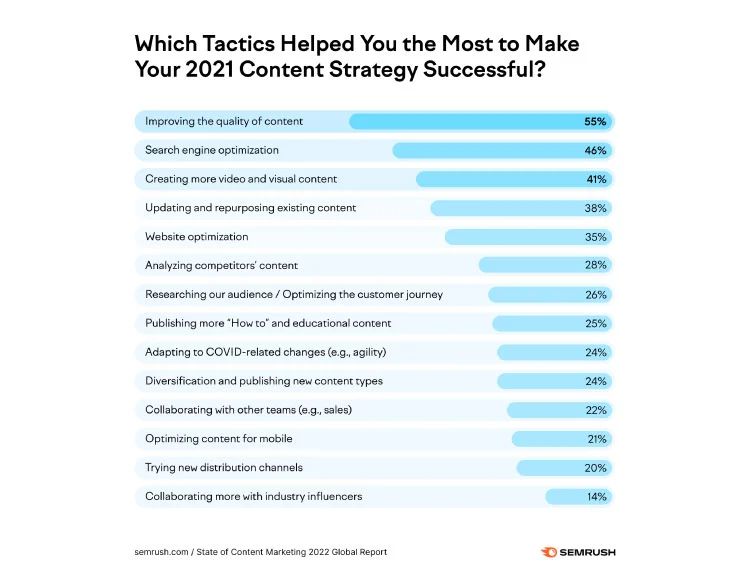20 Marketing Strategies for Startups [Growth-Focused]
Marketing strategies for startups have their own universe, sharing some characteristics with corporate marketing, but at a much different pace.
In fact, the faster pace of marketing, which is truly accelerated, is just the tip of the iceberg in startup marketing.
Overall, the strategies are different, the data capture methodologies are more efficient, and because of that, there’s less room for “shots in the dark.”
This is because startups have more urgent revenue and growth needs, with very aggressive goals and total motivation from all departments to make them happen.
Follow along with me as in this article, I’ll show you the main differences between marketing for startups and conventional marketing, and also share 20 strategies that we use daily here at Leadster.
All set?
Corporate Marketing vs. Startup Marketing

As we mentioned, there’s a big difference between corporate marketing and marketing for startups.
But it’s always worth emphasizing that, in theory, these differences shouldn’t exist. What startups bring to the table is a very efficient interpretation of their marketing principles, something all companies should do.
The difference is that, due to their natural characteristic of always seeking to grow more and faster, startups delve deep into marketing methodologies and apply them to extract maximum results.
That’s why we always find the most advanced marketing strategies in startups. They have more room to experiment because their philosophy is to fail fast and correct fast.
Here are some examples of concepts and methodologies of marketing for startups to illustrate:
Growth Marketing
Startups typically place great value on growth. All their marketing strategies are designed to extract maximum results from all their actions.
This is a fundamental difference from corporate marketing done in companies. Generally, there isn’t a team or a professional dedicated 100% to growth.
In startups, growth needs to be accelerated right from the start of their operations – the data from their initial actions will guide the creation of new, even more efficient ones.
When a startup begins, it’s necessary to innovate wherever possible, implement unconventional strategies, and strive to enter the market as soon as possible.
Growth hacking strategies blend with inbound marketing, guerrilla marketing, outbound, and TV commercials. Whatever the budget allows and is approved by the involved teams, proceeds to execution.
This is how the data comes in. And it needs to come in.
In established companies, corporate marketing already has the data it needs, and therefore its actions are based on other limitations: team expertise, allocated budget, the direction the management is envisioning, etc.
Data-Driven Marketing
After this initial phase of rapid creation and innovative strategies, startups come out richer in customer data.
You’ve seen articles online talking about how essential it is to know your target audience? Startups set aside common ground and do everything to capture as much information as possible.
Don’t worry, we’ll delve more deeply into these strategies in the next section of this article.
But getting back to the subject: after this initial phase, the startup is filled with data. Some examples:
- Through A/B testing, they know which language is most suitable for converting more;
- By publishing rich materials, they know which offers attracted the most customers;
- By conducting keyword research and creating an SEO-optimized blog, they know the most frequent questions from their audience;
- Using heat maps and eye tracking tools, they know which points on their landing pages need improvement;
- By sending emails, they know which Subject lines bring a higher open rate;
And so on. The more actions a startup performs, the more data it has. And the more data, the better these actions become.
That’s why we say that, in theory, marketing for all companies should be the same. These methods can be applied by any company. But marketing for startups simply cannot survive without them.
20 Marketing Strategies for Startups

It’s always good to talk about the differences that marketing for startups presents. But better than that is giving examples of what exactly is different.
I mentioned “methods,” “philosophies,” and “strategies” in the previous section, but we didn’t analyze concrete examples together. What methods are these?
To perfectly understand the difference between the two types of marketing – which, as we discussed, shouldn’t have any difference – we need to delve into the routines of a successful startup.
More specifically, what they do differently in marketing.
The time is now. See the 20 main marketing strategies for startups, focusing on accelerated growth and data interpretation:
Content Marketing Focus
According to HubSpot’s 2022 State of Marketing report, 97% of surveyed companies say they use content marketing in their growth strategies.
It’s very common for startups to place a lot of value on content. The possibilities with organic interaction are enormous and last for many years without a very large financial impact.
Here are the main channels that startups typically use in their content marketing:
Blogs for SEO
Blogs represent an incredible growth opportunity. In fact, two of Brazil’s leading marketing startups – Resultados Digitais and Rock Content – own the largest blogs on digital marketing in the country.
Having a blog optimized for SEO allows you to appear organically at the top of Google for searches related to your segment.
All results for the search “successful startups” on Google today are from blogs. Content marketing experts identified the term as relevant and crafted texts about them.
This identification is done through keyword research. We have a text that explains the concept better, check it out here.
But to summarize: through platforms like SemRush or Google Keyword Planner, you can find out how many searches the term “what is a startup” gets over a month.
In this case, the term “successful startups” has 590 monthly searches, on average. And the competition isn’t high. Crafting a good blog post attracts more visitors to your site, the first step in the inbound marketing funnel.
🔎 Dive Deeper: Lead Generation Blog - 10 Essential Strategies
YouTube
The strategy for YouTube is practically the same as for blogs: the difference is that you have a channel within the platform.
Keyword research is also done but through specialized (and paid 😕) tools like SemRush or Ahrefs.
The purpose of content production on YouTube is to bring more views and convert those views into visitors to your site or leads, by offering rich materials during the video or in the caption.
In the 2022 State of Marketing survey, HubSpot highlights video production as the third most used strategy within content marketing to get more results:

Podcasts
This content strategy is also super interesting to attract more audience and create your own audience.
Many startups use the audience from other podcasts by advertising and sponsoring episodes.
But the more patient ones, who create their own and feed it with quality content, can gain a great position in the market and convey their message at a much lower cost.
Social Media
Social media as a marketing strategy for startups is already common practice. In fact, any company today, when starting marketing, will always start with a social media profile.
The strategy is valid, but in a very saturated market, social media needs to offer more than the standard posts we usually see.
Successful startups use Instagram, Facebook, TikTok, and other networks as a platform to promote materials.
Thus, they can capture more leads and increase the audience on all their channels simultaneously.
🔎 Also read: How to Capture Sales Qualified Leads in 2024
Email Marketing
One of the most fundamental strategies in marketing for startups is email marketing.
And interestingly enough, it was digital marketing startups like HubSpot, Resultados Digitais, and Mailchimp that helped popularize the concept of smart email marketing.
A few years ago, email marketing was synonymous with SPAM. Your emails were divided between content you want to see (from people you know, work, etc.) and unwanted promotions.
Startups popularized the concept of content curation, newsletters, alerts of new available materials, and, in general, emails from companies that aren’t trying to sell you anything.
Today, according to HubSpot statistics, 4 out of 5 marketing departments prefer to stop doing social media rather than stop doing emails.
And there’s more: 89% of respondents said email is their biggest source of lead conversion.
These results, combined with the need to convert leads that growth brings, make email marketing one of the most popular strategies in marketing for startups.
Conversational Marketing
Another strategy widely used in marketing for startups is conversational marketing.
What conversational marketing does is bring a more humanized side to the navigation of companies’ websites that use it.
On a landing page, for example, instead of typing your data into a form, visitors have a chatbot that asks questions.
This significantly increases lead conversion, being a great support in inbound marketing strategies – and also in paid media.
🔎 Also read: What is Conversational Customer Engagement? How to Apply it?
Guerrilla Marketing
It’s not very common to find startups doing actions outside of digital, where it’s more difficult to capture data. But guerrilla marketing comes with an advantage: you can become news.
Here’s an example to inspire you. The Grid Toronto, a magazine, started its sales with a guerrilla marketing action: they painted the sidewalks with chalk next to their totem:
Not all startups will do guerrilla marketing, but for those that do, here are some basic recommendations:
- It’s ideal to hire an agency specialized in the service;
- It’s essential to have legal support to carry out the action;
- Your action should align with the expectations of your target audience;
- Don’t be conservative: aim high to impress;
- Film everything and use the material for an online campaign.
KPIs and Goal Definition
Well-identified goals and KPIs are the backbone of all marketing strategies for startups.
All of them, without exception, need to work with this methodology. Remember we talked about growth, right? KPIs are the indicators that show how your growth is.
MVP Philosophy Applied to Marketing
Have you heard of the minimum viable product?
This concept is well-known in startups, especially in technology startups. Basically, an MVP is when you deliver a product that, although not yet finalized, is still ready enough to fulfill what it promises.
A startup will create an innovative security system, for example. Its MVP is an app displaying real-time images, with chats with guards and status of the latest rounds.
The final product will be more than that – audio in cameras, a more user-friendly design, and other more advanced features. But for the market, the MVP is enough for now.
In marketing for startups, you will often encounter this situation. Waiting 1 month for a video script to be recorded or asking the CEO to record a long version and make some cuts?
Always think about the MVP philosophy. In marketing for startups, having a useful piece is often much better than having a perfect piece with all the beautiful details but takes time to complete.
Agile Methods Applied to Marketing Production
The most popular agile methods are Kanban and Scrum. They were popularized by technology startups and idealized by big names in the tech sector.
These are three project management methodologies. They determine work rituals, standardize deliveries, set deadlines, and determine the roles of everyone involved.
Marketing for startups is characterized by being quite frenetic. Production needs to be fast because the volume of materials is constantly growing.
In digital marketing, the more quality content you produce, the more data and opportunities you’re generating.
In our article about marketing plans, we expand a lot on Kanban and Scrum, talking individually about each one. It’s very worth checking out.
UX Design Applied to Marketing
Another very common point in marketing strategies for startups is the use of UX design wherever possible.
Normally, it’s used on the website and landing pages to increase conversion.
Back to the data conversation. Through tests and more tests, startups can understand the main frustrations of users on their pages.
By using UX design principles – or design focused on user experience – it’s possible to work better on each point of your materials to be displayed and innovate wherever possible.
One example is conversational marketing itself. Using landing pages that are chatbots is a strategy that startups are already implementing and it’s working great.
In the link above, you’ll find some examples. It’s worth it to understand better how UX design is applied in marketing for startups.
ABM – Account Based Marketing
ABM is a set of strategies used by specialized agencies and marketing teams to generate more sales in complex negotiation situations.
Some startups, especially those working in the B2B model, have sales processes that can take months to materialize.
In this scenario, making a few sales means having reduced growth. ABM is a response to this.
With customized strategies, startups that use ABM create extremely localized and personalized campaigns, seeking to capture the attention of their potential customers, generating more prospects and therefore, more sales.
🔎 Learn more: What is Account Based Marketing (ABM)? From zero to first account
Paid Media
Paid media strategies on search engines and social networks are widely used by startups to generate more leads more quickly.
Campaigns are usually done on Google Ads and Meta (formerly Facebook). While organic traffic work is being built, startups need to invest in paid media to get more data and leads.
We have a very interesting article about the differences between paid and organic traffic. In it, we talk more about the differences of each strategy.
Another must-read is the guide we’ve put together on how to turn your paid traffic into a machine for generating qualified leads.
In this second one, we show which strategies we use here at Leadster, in addition to explaining some fundamental metrics.
Social Selling
Social selling is a strategy that combines social networks, content, and sales to generate more revenue and growth for startups.
In it, brands create profiles on social networks – especially on Facebook, Twitter, and LinkedIn – and start creating pieces showing the potential of their product or service in the lives of their potential customers.
A large part of brands does the basics of social selling without even knowing. But it can go far beyond the basics.
Profiles of key employees on LinkedIn, for example, are a form of social selling. Showing what the company is doing in a more casual way is great for generating a prospect-brand relationship.
The keyword for social selling is this: relationship.
Outbound
Outbound is gaining renewed strength in startups with an increasingly larger use of creative copywriting techniques for advertisements.
Outbound is the opposite of inbound. In it, the brand goes to the customer to show its products and services.
The thing is, for a long time, outbound was seen as invasive because of traditional marketing tactics. But with digital marketing, this has been changing a lot.
We have an article that talks a lot about outbound marketing in B2B. Check out this compilation of the six stages of the outbound process that we took from it:
Lead research; Active prospecting via phone, email, or social networks; Connection with the prospected lead; Qualification of the lead among the company’s filters and segmentation; Negotiation, if the lead fits within the ideal customer parameters; Closing the deal.
Referral Programs
Startups create ecosystems. Referral programs are part of this effort.
Referral programs are partnerships established between startups and people who are impacted by their services.
An example: here at Leadster, we work with a partnership program where we help gather clients for digital marketing agencies.
Resultados Digitais, through its RD Partner program, does the same thing.
And a very recent startup, Corisco, brings together freelance marketing professionals with agencies.
Engineering as Marketing
The reality of the Internet today is the fierce competition for users’ attention.
And since the boom of inbound marketing from 2010 onwards, brands compete in a very competitive content landscape to position themselves as authorities in their market.
Engineering as marketing is a concept that seeks to go beyond the content being produced today to answer users’ questions.
According to this philosophy, brands achieve more growth when they create truly useful tools for their users.
Engineering as marketing isn’t easy. Let’s not deceive anyone here by saying it is. You need a lot of creativity and a very diverse team of specialists to be able to create your tools.
And funny enough: these are the qualities that every startup prioritizes when hiring their team 😉
Public Relations
Startups need to grow, and they need to grow fast. One of the best ways to achieve this growth is with a PR team (or person).
A startup’s PR is responsible for seeking relationship opportunities with the general community.
This is done by creating communication channels with the press, seeking participation in digital channels – podcasts, for example – and communicating their differentiators in the market, etc.
The idea is for the startup to be recognized for what it is and for what it does by as many people as possible.
Product-Led Growth
Back in 1960, David Ogilvy said that the job of an advertiser isn’t to lie about their product. It’s to highlight its main features.
According to him and other great names from the early days of contemporary advertising, good products are more successful than bad ones.
Therefore, the marketing strategy for good products is more likely to succeed, simply because the product is good.
This idea is expanded in product-led growth, a philosophy that indicates that the path to successful marketing is and always will be the user experience with your product.
This is becoming increasingly popular with digital products. They need to be good. And the fact that they are good is enough to boost the results of marketing for startups.
Feeling inspired by the 20 marketing strategies for startups? Did you notice we talked a lot about one magical word here: growth.
The truth is that growth is the fundamental component in startups. And in many cases, this need is also very present in already established companies.
Before you go, you should check out our free trial. Today, it’s getting harder and harder to find startup websites without a chatbot.
Why? Simple: they generate leads automatically, and feed your Funnel without you having to do a whole lot of tinkering.
Test it today for 14 days. It’s free – no credit card required.
Thank you for reading. See you in the next article.







